Get Data
Summary:
This data set provides two data files in text format (.txt). One file contains a long time series of biomass measurements made between 1954 and 1983 on a virgin meadow steppe in the Central-Chernozem V.V. Alyekhin Natural Reserve, Kursk Region, Russia. The second file contains monthly and annual climate data for the study site for the period 1947-1983.
Above-ground live biomass measurements were made at biweekly to monthly intervals over the entire 30-year time series. Discontinuous measurements of above-ground standing dead matter and litter biomass (1956-1983) and below-ground live and dead biomass (1972-1973 and 1981-1983) were also made. Cumulative ANPP was estimated at the end of the growing season (1956-1963 and 1972-1973) and monthly (1982-1983). Averaged over the time series, above-ground live phytomass, standing dead, and litter biomass were estimated to be 362, 344, and 424 g/m2 (dry matter weight), respectively, while below-ground phytomass and mortmass were 910 and 1,370 g/m2 (dry matter weight), respectively. ANPP was estimated to be 774 g/m2/yr and BNPP was estimated to be 1,700 g/m2/yr for a TNPP estimate of 2,474 g/m2/yr.
The study site is one of eight major grassland types of Eurasia which encompass an extremely wide climatic gradient in the direction of increasing maximum summer temperatures and continentality and decreasing precipitation in a north-west to the south-east band of steppes in the European and Asian parts of the former USSR (Commonwealth of Independent States). Kurst, on rich loamy chernozem soil, is one of the most productive upland grassland ecosystems of Russia with annual mean maximum/minimum temperatures of 24.8/-14.4 C and annual mean precipitation of 582.7 mm for the period 1947-1983.
Revision Notes: Only the documentation for this data set has been modified. The data files have been checked for accuracy and are identical to those originally published in 1996.
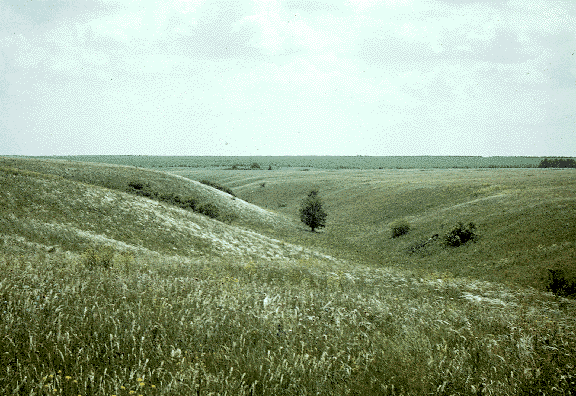
Figure 1. View along a steppe gully at the Kursk grassland site, Russia. (the tall grass is is typical of unmowed, ungrazed meadow steppe. The white patches are Stipa capillata (feather grass). (Photograph taken July 1989 by Dr. R. Zlotin, Indiana University, Bloomington, IN, USA).
Additional Documentation
The NPP data collection contains field measurements of biomass, estimated NPP, and climate data for terrestrial grassland, tropical forest, temperate forest, boreal forest, and tundra sites worldwide. Data were compiled from the published literature for intensively studied and well-documented individual field sites and from a number of previously compiled multi-site, multi-biome data sets of georeferenced NPP estimates. The principal compilation effort (Olson et al., 2001) was sponsored by the NASA Terrestrial Ecology Program. For more information, please visit the NPP web site at http://daac.ornl.gov/NPP/npp_home.shtml
Data Citation:
Cite this data set as follows:
Gilmanov, T.G. 2015. NPP Grassland: Kursk, Russia, 1954-1983, R1. Data set. Available on-line [http://daac.ornl.gov] from Oak Ridge National Laboratory Distributed Active Archive Center, Oak Ridge, Tennessee, USA. http://dx.doi.org/10.3334/ORNLDAAC/149
This data set was originally published as:
Gilmanov, T.G. 1996. NPP Grassland: Kursk, Russia, 1954-1983. Data set. Available on-line [http://daac.ornl.gov] from Oak Ridge National Laboratory Distributed Active Archive Center, Oak Ridge, Tennessee, U.S.A.
Table of Contents:
- 1 Data Set Overview
- 2 Data Description
- 3 Applications and Derivation
- 4 Quality Assessment
- 5 Acquisition Materials and Methods
- 6 Data Access
- 7 References
1. Data Set Overview:
Project: Net Primary Productivity (NPP)
Long-term ecological research at grasslands within the former USSR collected a large amount of data on phytomass, productivity and element cycling, together with climatic and soil regimes for various types of grassland ecosystems. These grasslands are found in different natural "continentality" climatic zones in the direction of increasing maximum summer temperatures, decreasing precipitation north-west to the south-east. The grassland types range from the luxuriant highly productive meadow-steppes of Central Russia to the ultra continental steppes of Central Asia and the arid ephemeral grasslands in the Middle-Asian republics of the former USSR.
The results of the USSR studies are mostly reported in the Russian literature but were summarized and used more recently by Gilmanov et al. (1997) to assess grassland differences and CENTURY model robustness across this wide environmental gradient.
The Kursk data set contains biomass measurements made at biweekly or monthly intervals over a 30-year period between 1954 and 1983. There is an unbroken record of above-ground live biomass measurements over the entire time series. Discontinuous records of above-ground standing dead matter and litter biomass (1956-1983) and below-ground live and dead biomass (1972-1973 and 1981-1983) were also provided. Cumulative ANPP was estimated at the end of the growing season (1956-1963 and 1972-1973) and monthly (1982-1983). Climate data for Kursk are available for the period 1947-1983. Data for the Kursk site were originally reported [in Russian] in Alekhin (1934); Semyonova-Tyan-Shanskaya (1966); Utekhin (1977); Khoang (1975); Gilmanov and Bazilevich (1983); and Bazilevich et al. (1988). A comprehensive description of the rich chernozem soil of the Kursk Natural Reserve is provided in a monograph by Afanasyeva (1966).
Averaged over the time series, above-ground live phytomass, standing dead, and litter biomass were estimated to be 362, 344, and 424 g/m2 (dry matter weight), respectively, for a total above-ground biomass weight of 1,130 g/m2. Below-ground phytomass and mortmass were 910 and 1,370 g/m2 (dry matter weight), respectively, for a total above-ground biomass weight of 2,280 g/m2 (Table 1, Gilmanov et al., 1997). ANPP was estimated to be 774 g/m2/yr and BNPP was estimated to be 1,700 g/m2/yr for a TNPP estimate of 2,474 g/m2/yr (Table 1, Gilmanov et al., 1997). These NPP values generally agree with estimates for a Kursk meadow steppe published in Olson et al. (2013a, b) and Scurlock and Olson (2013) when converted to grams of carbon per meter square per year using a conversion factor of 0.45.
2. Data Description:
Spatial Coverage
Site: Kursk, Russia
Site Boundaries: (All latitude and longitude given in decimal degrees)
| Site (Region) | Westernmost Longitude | Easternmost Longitude | Northernmost Latitude | Southernmost Latitude | Elevation (m) |
|---|---|---|---|---|---|
| Kursk, Russia | 36.5 | 36.5 | 51.67 | 51.67 | 250 |
Spatial Resolution
Information not available
Temporal Coverage
1954-1983. There is a continuous record of above-ground live biomass measurements over the entire 30-year time series. There are discontinuous records of above-ground standing dead matter and litter biomass (1956-1983), below-ground live and dead biomass (1972-1973 and 1981-1983), and cumulative ANPP (1956-1963, 1972-1973, and 1982-1983). Climate data are available from 1947-1983.
Temporal Resolution
Above-ground live biomass, standing dead matter and litter biomass measurements were made at biweekly to monthly intervals. Below-ground live and dead biomass measurements were made monthly. Cumulative ANPP was estimated at the end of the growing season for some years and monthly for others.
Data File Information
Table 1. Data file descriptions
| FILE NAME | TEMPORAL COVERAGE | FILE CONTENTS |
|---|---|---|
| krs_npp.txt | 1954/04/15-1983/10/15 | Above- and below-ground biomass data and cumulative ANPP for the Kursk grassland site |
| krs_cli.txt | 1947/01/01-1983/12/31 | Climate data from a weather station near the Kursk grassland site |
NPP Data. Biomass and cumulative ANPP estimates are provided in one text file (.txt format) (Table 2). The variable values are delimited by semicolons. The first 18 lines are metadata; data records begin on line 19. Missing data are denoted by the value -999.9. All biomass units are expressed in g/m2 (dry matter weight). Cumulative ANPP is expressed as g/m2 per sampling date (dry matter weight).
Table 2. Column headings in NPP file.
| COLUMN HEADING | DEFINITION | UNITS |
|---|---|---|
| Site | Site where data were gathered (code refers to site identification) | text |
| Treatmt | Long term management of site (code refers to treatment described in metadata in data file) | |
| Year | Year in which data were collected | yyyy |
| Mn | Month in which data were collected | mm |
| Dy | Day on which data were collected | dd |
| Tyear | Date in decimal year (year plus the Julian date divided by 365) | numeric |
| AGbiomass | Above-ground biomass | g/m2 Dry Weight |
| Stdead | Standing dead biomass | |
| litter | Litter found above ground | |
| AGtotmatter | Total above-ground biomass (live + dead + litter) | |
| BGbiomass | Below-ground live biomass | |
| BGdead | Below-ground dead | |
| BGtotmatter | Total below-ground biomass (live + dead) | |
| ANPP | Above-ground net primary production 1 | g/m2/sampling date |
| CUMANPP | Cumulative above-ground net primary production |
Note: 1ANPP results not available. Parameter included for format consistency with other NPP data sets.
Sample NPP Data Record
| Site;Treatmt;Year;Mn;Dy;Tyear;AGbiomass;Stdead;litter;AGtotmatter;BGbiomass;BGdead;BGtotmatter;ANPP;CUMANPP [units g/m2] krs;lngtrm ;1954;04;15;1954.290; 20.0;-999.9;-999.9;-999.9;-999.9;-999.9;-999.9;-999.9;-999.9 krs;lngtrm ;1954;05;15;1954.370; 100.0;-999.9;-999.9;-999.9;-999.9;-999.9;-999.9;-999.9;-999.9 krs;lngtrm ;1954;06;15;1954.450; 200.0;-999.9;-999.9;-999.9;-999.9;-999.9;-999.9;-999.9;-999.9 krs;lngtrm ;1954;07;15;1954.540; 403.0;-999.9;-999.9;-999.9;-999.9;-999.9;-999.9;-999.9;-999.9 krs;lngtrm ;1954;08;15;1954.620; 100.0;-999.9;-999.9;-999.9;-999.9;-999.9;-999.9;-999.9;-999.9 krs;lngtrm ;1954;09;15;1954.710; 80.0;-999.9;-999.9;-999.9;-999.9;-999.9;-999.9;-999.9;-999.9 krs;lngtrm ;1954;10;15;1954.790; 60.0;-999.9;-999.9;-999.9;-999.9;-999.9;-999.9;-999.9;-999.9 krs;lngtrm ;1954;11;15;1954.870; 40.0;-999.9;-999.9;-999.9;-999.9;-999.9;-999.9;-999.9;-999.9 krs;lngtrm ;1955;04;15;1955.290; 7.0;-999.9;-999.9;-999.9;-999.9;-999.9;-999.9;-999.9;-999.9 ... krs;lngtrm ;1982;05;19;1982.380; 150.0; 182.0; 138.0; 470.0; 972.0; 783.0;-999.9;-999.9; 136.0 krs;lngtrm ;1982;06;16;1982.460; 632.0; 65.0; 370.0;1067.0;1205.0;1337.0;-999.9;-999.9; 733.0 krs;lngtrm ;1982;07;18;1982.550; 770.0; 183.0; 371.0;1324.0;1418.0; 851.0;-999.9;-999.9; 990.0 krs;lngtrm ;1982;08;18;1982.630; 754.0; 332.0; 320.0;1406.0;1948.0;1385.0;-999.9;-999.9; 990.0 krs;lngtrm ;1982;09;15;1982.710; 473.0; 244.0; 346.0;1063.0; 700.0;1057.0;-999.9;-999.9; 990.0 krs;lngtrm ;1982;10;15;1982.790; 60.0; 599.0; 208.0; 867.0; 811.0;1102.0;-999.9;-999.9;1020.0 ... |
Climate Data. Climate data are provided in one text file (.txt format). The first 18 lines are metadata; data records begin on line 19. The variable values are delimited by semi-colons. There are no missing values.
Sample Climate Data Record
| Site;Temp;Parm; Jan; Feb; Mar; Apr; May; Jun; Jul; Aug; Sep; Oct; Nov; Dec; Year krs;mean;prec; 33.0; 27.0; 32.0; 37.5; 54.9; 62.6; 79.6; 67.8; 45.8; 47.0; 47.1; 48.3; 582.7 krs;mean;tmax; -5.3; -4.7; 0.0; 11.3; 19.2; 23.0; 24.2; 23.4; 17.4; 9.9; 2.5; -2.3; 24.8 krs;mean;tmin;-12.4;-11.7; -6.6; 2.1; 7.9; 12.0; 13.3; 12.3; 7.6; 2.2; -3.3; -7.5; -14.4 krs;numb;prec; 37.0; 37.0; 37.0; 37.0; 37.0; 37.0; 37.0; 37.0; 37.0; 37.0; 37.0; 37.0; 37.0 krs;numb;tmax; 37.0; 37.0; 37.0; 37.0; 37.0; 37.0; 37.0; 37.0; 37.0; 37.0; 37.0; 37.0; 37.0 krs;numb;tmin; 37.0; 37.0; 37.0; 37.0; 37.0; 37.0; 37.0; 37.0; 37.0; 37.0; 37.0; 37.0; 37.0 krs;stdv;prec; 18.5; 15.2; 15.3; 19.8; 34.3; 32.2; 47.3; 37.5; 27.4; 34.1; 24.7; 23.9; 97.8 krs;stdv;tmax; 3.6; 3.3; 2.7; 2.8; 2.5; 2.0; 1.9; 2.0; 2.2; 2.4; 2.3; 2.6; 1.9 krs;stdv;tmin; 4.9; 4.6; 3.1; 2.2; 2.1; 1.9; 1.5; 1.3; 1.4; 2.2; 2.3; 3.1; 4.2 krs;1947;prec; 9.1; 19.3; 25.0; 53.6; 30.1; 42.0; 51.5; 96.9; 51.2; 19.6; 70.0; 79.1; 547.4 krs;1947;tmax;-10.6; -7.7; -1.9; 11.6; 18.6; 25.5; 27.0; 23.5; 18.4; 7.2; 3.6; 0.8; 27.0 krs;1947;tmin;-13.2;-12.6; -4.3; 3.1; 3.6; 11.4; 13.7; 12.7; 8.2; -0.1; -2.9; -4.3; -13.2 … Where, Temp (temporal) - specific year or long-term statistic: mean = mean based on all years numb = number of years stdv = standard deviation based on all years Parm (parameter): prec = precipitation for month or year (mm) tmax = mean maximum temperature for month or year (C) tmin = mean minimum temperature for month or year (C) |
3. Data Application and Derivation:
Data on biomass dynamics and productivity were recently assembled and checked as part of a series of grassland data sets covering a wide range of climate and "continentality" (increasing maximum summer temperatures, decreasing precipitation) from the north-west to the south-east in the Commonwealth of Independent States (former USSR) (Gilmanov et al., 1997). These grasslands represent a wide environmental gradient from the luxuriant highly productive meadow-steppes of Central Russia to the ultra continental steppes of Central Asia and the arid ephemeral grasslands in the Middle-Asian republics of the former USSR. The field data from these study sites were used by Gilmanov et al. (1997) to assess grassland differences and CENTURY model robustness.
Grassland biomass dynamics data are provided for comparison with models and estimation of NPP. Climate data are provided for use in driving ecosystem/NPP models.
4. Quality Assessment:
Net primary production of grasslands is subject to a number of different methods of estimation from biomass data, some of which may be inappropriate for particular biome types. Methodology of estimation/calculation needs to be taken into account, as well as methodology of measurement, when making comparisons between different regions. Errors in biomass measurement may also occur between different study sites. For short time series of data it may be assumed that measurement methodology remains consistent; however, over very long time series changes in staff, tools, etc. may lead to "calibration" errors.
The Kursk site has an uniquely long and detailed time series of phytomass observations. The results of the testing the CENTURY model against the Kursk field data appear to be quite good.
5. Data Acquisition Materials and Methods:
Site Information
The Kursk site is a virgin meadow steppe in the Central-Chernozem V.V. Alyekhin Natural Reserve in the Kursk and Belgorod area of Russia. It is located about 18 km south of the city of Kursk. The nature reserve is one of the world's most well-known, well-studied and largest steppe "zapovednik" (English translation = nature sanctuary) where steppe and forest-steppe biomes are preserved in their natural state. Five parts of this zapovednik occupy the area of 4,847 ha. This world significant nature reserve is named after the famous Russian geobotanist Vasiliy Vasiliyevich Alyekhin (1852-1946), a native of Kursk, who studied local steppe and forest-steppe landscapes as early as the beginning of the 20th century and promoted their strict protection from agricultural exploitation. In 1935, the zapovednik was successfully established. The nature reserve was extended in 1968 and in 1979, and now is a part of the worldwide network of biosphere reserves established under the patronage of UNESCO.
Kursk, on rich loamy chernozem soil, is one of the most productive upland grassland ecosystems of Russia and has been studied for many years. Dominant species of this plant community include Bromus riparius, Stipa pennata, Poa angustifolia, Agropyron intermedium, Filipendula hexapetala, Fragaria viridis. The meadow is noted by its high species richness, with up to 77 species per 1 m2 and 120 species per 100 m2 (Alekhin, 1934). The 37-year climate record and 30-year time above-ground phytomass series for the Kursk site cover a wide diversity of weather conditions. The peak phytomass ranged from 202 g/m2 in 1963 (a cold winter and spring followed by a dry and hot May) to a high of maximum phytomass of 770 g/m2 in 1982 (favorable weather in all seasons of the year).
Table 3. Site characteristics
| Description | Values |
|---|---|
| mean annual precipitation | 582.7 mm |
| mean monthly minimum temperature | -12.4 degrees C (Jan) |
| mean monthly maximum temperature | 24.3 degrees C (July) |
| vegetation type | meadow steppe |
| dominant species | Bromus riparius (C3) |
| historical long-term management regime | annual mowing |
| max above-ground live biomass (typical month) | 362 g/m2 (July) |
| soil type | chernozem/haplaboroll |
| soil pH | 6.3 |
| soil texture (sand/ silt/ clay) | 0.32 / 0.31 / 0.37 |
| soil carbon content | 10,430 g/m2 (0-20 cm) |
| soil nitrogen content | 910 g/m2 (0-20 cm) |
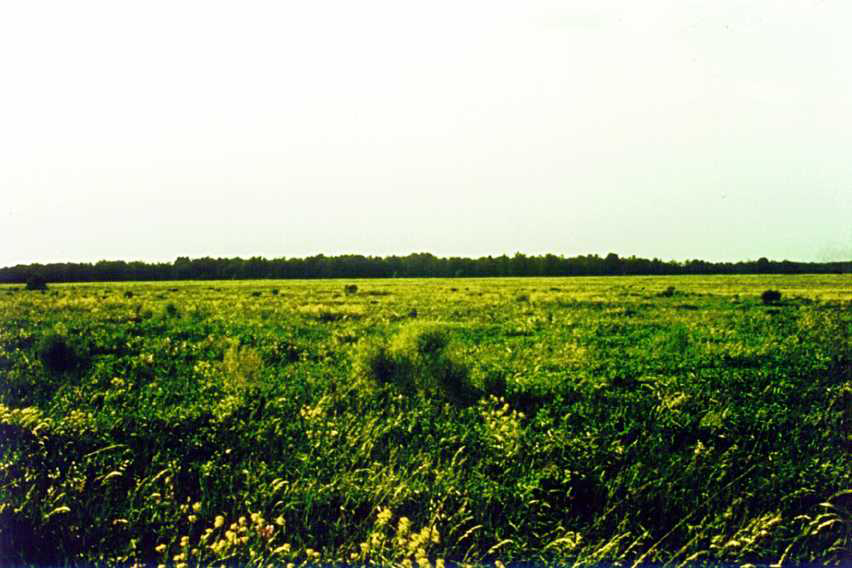
Figure 2. The principal "virgin" meadow steppe at the Kursk grassland study site, shown at the peak of the growing season. (Note the windbreak in the background. Photograph taken at the end of July 1983 by Dr. T.G. Gilmanov, South Dakota State University, USA).
Methods
Methodological aspects of field experimental studies of biomass and production of grassland ecosystems in the Commonwealth of Independent States (former USSR) were summarized by Titlyanova (1988) [in Russian]. The methods of field measurements of above-ground and below-ground biomass in Russian grasslands are based on the harvest technique and with respect to sampling area, replication, etc., are very close to the methods used by western ecologists during the International Biological Programme (IBP) studies (e.g., Milner and Hughes, 1968; Sims and Coupland, 1979). The Russian approach to estimation of the annual production of grassland plant communities (with subdivision on above- and below-ground components) is based on a calculation procedure utilizing data of repeated sampling (usually biweekly) during the season of live, standing dead and litter fractions of phytomass. This method of calculation gives the estimates of production which are 1.6 to 2.0 times higher than the seasonal maximum of the standing crop of the corresponding phytomass fraction (Titlyanova, 1988).
This data set is part of a series of grassland data sets assembled and checked by Dr. Tagir Gilmanov (Gilmanov et al., 1997) from primary sources originally reported [in Russian] in Alekhin (1934), Semyonova-Tyan-Shanskaya (1966), Utekhin (1977), Khoang (1975), Gilmanov and Bazilevich (1983), and Bazilevich et al. (1988). A comprehensive description of the rich chernozem soil of the Kursk Natural Reserve is provided in a monograph by Afanasyeva (1966) [in Russian].
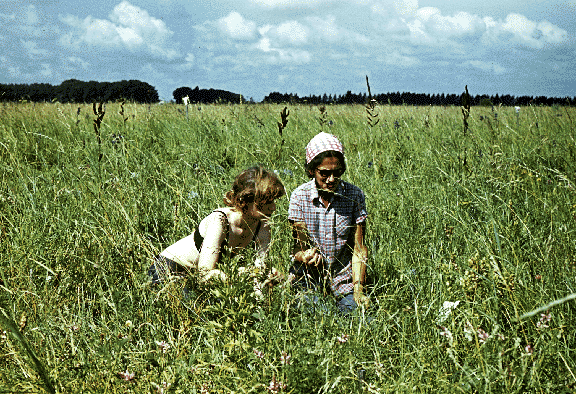
Figure 3. Clipping above-ground biomass at the Kursk grassland site, Russia. (Dr. Kira Khodashova and student Nina N., Moscow State University, are estimating monthly live biomass increment for a mowed treatment area. Photograph taken July 1977 by Dr. R. Zloti n, Indiana University, Bloomington, IN, USA).
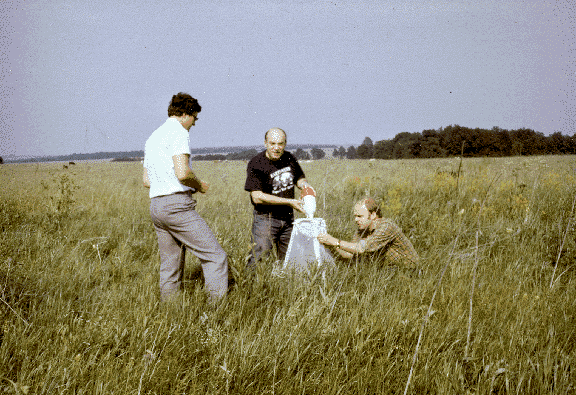
Figure 4. Vacuuming insects from the grass layer at the Kursk grassland site, Russia. (left to right: Nikolai Maleshin, Director of the Central-Chernozem State Biosphere Reserve; Roman Zlotin and Gennady Domnikov, professor and graduate student, Institute of Geography, USSR Academy of Science. Photograph taken mid-1980s).
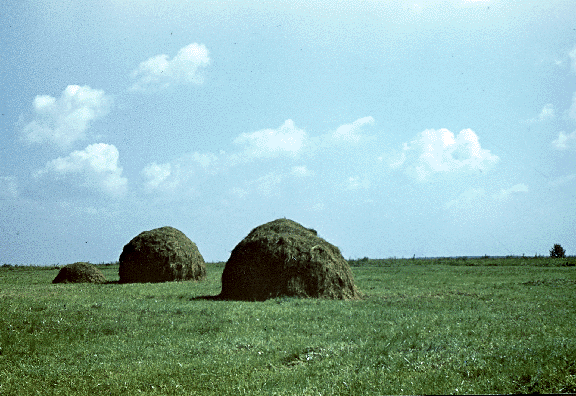
Figure 5. Haystacks after mowing at the Kursk grassland site, Russia. [This represents one of the three main site treatments for conservation of steppe ecosystems at the Central-Chernozem Reserve. Hay is mowed annually in July: after four years, there is one year of rest. In the background the second treatment is just visible (grazed steppe, with cows). The third treatment is a control (i.e., unmowed and ungrazed). Photograph taken early July 1979 by Dr. R. Zlotin, Indiana University, Bloomington, IN, USA.]
6. Data Access:
This data set is available through the Oak Ridge National Laboratory (ORNL) Distributed Active Archive Center (DAAC).
Data Archive:
Web Site: http://daac.ornl.gov
Contact for Data Center Access Information:
E-mail: uso@daac.ornl.gov
Telephone: +1 (865) 241-3952
7. References:
Afanasyeva, E.A. 1966. Chernozems of the Middle-Russian Upland. Nauka, Moscow. 224 pp. (in Russian).
Alekhin, V.V. 1934. The Central Chemozem steppes. Kommuna Publ., Voronezh, 96 pp. (in Russian).
Bazilevich, N.I., E.I. Shmakova, A.A. Tishkov, and T. Tran. 1988. Grassland ecosystems of the Russian Plain. The Kursk Region, pp. 58-66. IN: Ilyin, V.B. (ed.). Biologicheskaya produktivnost' travyanykh ecosistem [Biological Productivity of Herbaceous Ecosystems]. Nauka, Moscow. (in Russian).
Gilmanov, T.G,. and N.I. Bazilevich. 1983. Conceptual balance model of the organic matter cycling in an ecosystem as the theoretical basis for monitoring, p. 7-57. IN: V.E. Sokolov and N.I. Bazilevich (eds.). The Theoretical Foundations and Experience of Ecological Monitoring. Nauka, Moscow. (in Russian).
Gilmanov, T.G., W.J. Parton and D.S. Ojima. 1997. Testing the CENTURY ecosystem level model on data sets from eight grassland sites in the former USSR representing a wide climatic/soil gradient. Ecological Modelling 96: 191-210. doi: 10.1016/S0304-3800(96)00067-1
Khoang, T. 1975. Seasonal dynamics of the above- and belowground biomass of the plants of the meadow steppe. Bull. Moscow Univ. Ser. Biol. Soil Sci. 3: 58-64 (in Russian).
Milner, C., and R.E. Hughes. 1968. Methods for the Measurement of the Primary Production of Grassland. IBP Handbook No.6. Blackwell, Oxford.
Olson, R.J., K.R. Johnson, D.L. Zheng, and J.M.O. Scurlock. 2001. Global and Regional Ecosystem Modeling: Databases of Model Drivers and Validation Measurements. ORNL Technical Memorandum TM-2001/196. Oak Ridge National Laboratory, Oak Ridge, Tennessee, U.S.A.
Olson, R.J., J.M.O. Scurlock, S.D. Prince, D.L. Zheng, and K.R. Johnson (eds.). 2013a. NPP Multi-Biome: Global Primary Production Data Initiative Products, R2. Data set. Available on-line [http://daac.ornl.gov] from the Oak Ridge National Laboratory Distributed Active Archive Center, Oak Ridge, Tennessee, U.S.A. doi:10.3334/ORNLDAAC/617
Olson, R.J., J.M.O. Scurlock, S.D. Prince, D.L. Zheng, and K.R. Johnson (eds.). 2013b. NPP Multi-Biome: NPP and Driver Data for Ecosystem Model-Data Intercomparison, R2. Data set. Available on-line [http://daac.ornl.gov] from the Oak Ridge National Laboratory Distributed Active Archive Center, Oak Ridge, Tennessee, U.S.A. doi:10.3334/ORNLDAAC/615
Scurlock, J.M.O., and R.J. Olson. 2013. NPP Multi-Biome: Grassland, Boreal Forest, and Tropical Forest Sites, 1939-1996, R1. Data set. Available on-line [http://daac.ornl.gov] from Oak Ridge National Laboratory Distributed Active Archive Center, Oak Ridge, Tennessee, U.S.A. doi:10.3334/ORNLDAAC/6533
Semyonova-Tyan-Shanskaya, A.M. 1966. Dynamics of the steppe vegetation. Nauka, Moscow-Leningrad. 169 pp. (in Russian).
Sims, P.L., and R.T. Coupland. 1979. Producers, pp. 49-72. IN: Coupland, R.T. (ed.). Grassland Ecosystems of the World: Analysis of Grassland and Their Uses. Cambridge University Press. 432 pp.
Titlyanova, A.A. 1988. Methodology and methods of studying of the production-destruction processes in herbaceous ecosystems, pp. 3-10. IN: Ilyin, V.B. (ed.). Biologicheskaya produktivnost' travyanykh ecosistem [Biological productivity of herbaceous ecosystems]. Nauka, Novosibirsk. (in Russian).
Utekhin, V.D. 1977. Primary biological productivity of the forest-steppe ecosystems. Nauka, Moscow. 146 pp. (in Russian).